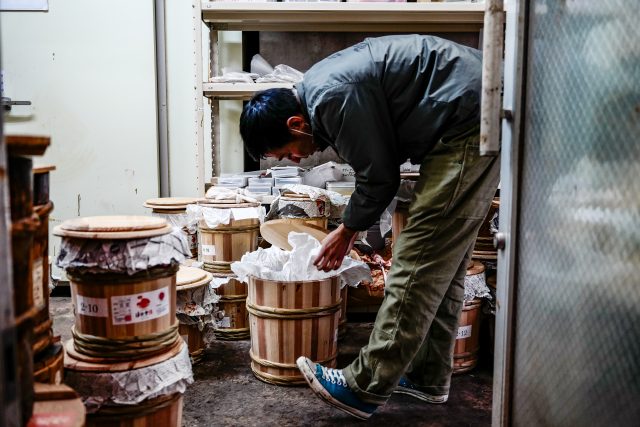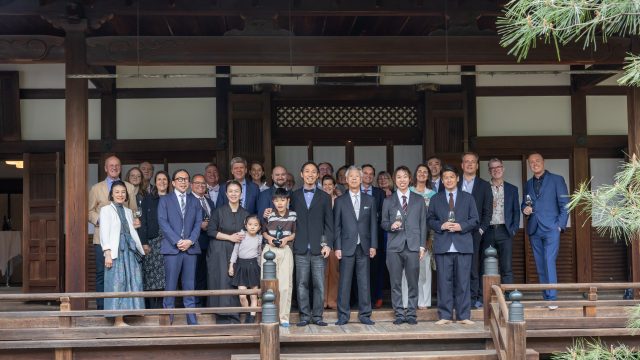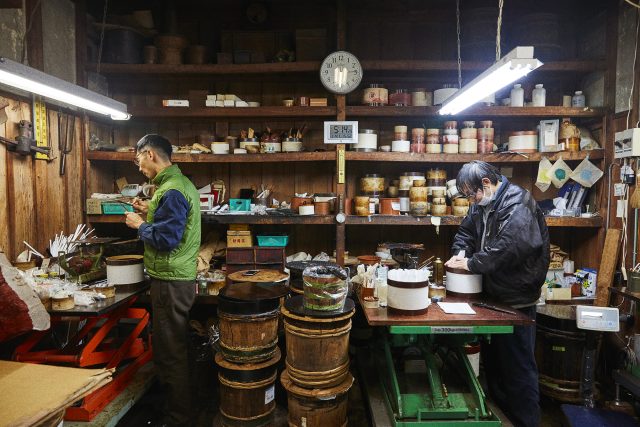This year's Primum Familiae Vini (PFV) Prize has been awarded to traditional Japanese lacquer manufacturer Tsutsumi Asakichi Urushi. Louis Thomas finds out the surprising ways that this craft is connected to winemaking.

PFV is a group of Europe's most important wine dynasties. Among the illustrious names in its membership of 12 are the likes of the Antinori family, the Rothschilds, the Symingtons and Torres.
In 2020, PFV launched a prize to recognise the importance of family-run businesses outside of the wine sector. The first recipient of the biennial award, granted in 2021, was Belgian violin-making workshop Maison Bernard,
and in 2023 it went to textile manufacturer Brun de Vian-Tiran. The 2025 prize marks the first time that a non-European company has won.
Founded in Kyoto in 1909 and now under the fourth generation of family ownership, Tsutsumi Asakichi Urushi specialises in the refinement of resin into lacquer, also known as 'urushi' in Japan, for use on items of furniture, religious artefacts and artworks and buildings.
PFV president (and Symington Family Estates co-CEO) Charles Symington remarked: "Selecting a winner among so many remarkable family enterprises is always a challenge, but Tsutsumi Asakichi Urushi stood out for their extraordinary commitment to both tradition and innovation. Their ability to uphold a centuries-old craft while introducing UV-resistant lacquer and restoring national treasures like the Nikko Toshogu Shrine reflects the resilience and excellence we value deeply at PFV. They embody the spirit of what we call 'the world’s most beautiful family business'."
"Just as a winemaker must understand the nuances of each harvest to craft a wine of character, a lacquer artisan must read each batch of raw resin to refine it with precision," continued Symington. "In both crafts, the mastery lies in handling nature’s variability and transforming it into something enduring, beautiful, and meaningful. They are both profoundly sensorial and artisanal processes—blending heritage, precision, and a commitment to sustainability."

Takuya Tsutsumi, the great-grandson of company founder Asakichi Tsutsumi, also noted a number of similarities between these crafts: "One of the most significant is that both crafts begin with cultivating the raw materials—lacquer comes from the urushi tree, while wine comes from grapevines. In both cases, the climate, soil, and natural environment play a crucial role, and the quality of the materials varies depending on the year, location, and method of harvesting."
"For example, in lacquer production, the characteristics of the sap, a mixture of resin and other components, can differ greatly depending on where, when, and how it is collected," Tsutsumi explained. "These subtle differences must be carefully assessed in order to adjust the gloss, viscosity, and drying time to meet the specific needs of the craftsmen who use the lacquer. The artisans who apply the lacquer also play a key role, adjusting the conditions of both the lacquer and the workspace to achieve the best possible finish."
"Likewise, in winemaking," he continued, "the grapes are transformed by the hands of skilled makers, and the final product continues to evolve through the choices of those who drink it – how it is aged, and how it is paired with food – all of which bring out its full character. In essence, both lacquer and wine share a deep relationship between nature and human touch at every stage – from growing the materials, to crafting them, to how they are ultimately used or enjoyed. It is within this dynamic relationship that something truly remarkable is born."
Endangered crafts
In the last four decades, lacquer demand in Japan has plummeted to a tenth of what it once was, a drop caused by the rise of synthetic materials in a increasingly consumerist society.
"Even young people who study lacquer face limited job opportunities after graduation. The entire cycle of our work as a lacquer manufacturer – refining sap from urushi trees and delivering it to artisans – can only function with the support of lacquer painters and those who grow the trees," revealed Tsutsumi. "If lacquerware products are not widely used, these craftspeople lose their place in the world."
It might be argued that, in the context of a changing climate and shifting tastes, the wine industry is also in a precarious position at present.
"The PFV Prize was born from a desire to spotlight family-owned companies that preserve savoir-faire while embracing the future," said Symington. "In a world often focused on scale and speed, these crafts remind us of the value of slowness, mastery, and connection. By awarding the PFV Prize to a lacquer company, we’re helping bring global attention to traditions that risk being forgotten. The prize not only provides financial support but also tells a story—one that inspires new generations and connects these crafts to modern conversations around sustainability, identity, and beauty."
Tsutsumi argued that there is still a place for family-run businesses practicing traditional trades in the modern day: "Because no two natural materials are exactly the same, working with them can be challenging. But it is precisely in that unpredictability where the true depth and fascination lie. Scientific knowledge alone is not enough; what’s crucial is the intuitive understanding – what we might call 'sensitivity' – that comes from spending many years directly working with the materials."

"Family-run businesses are the strongest foundation for passing down this kind of sensitivity," added Tsutsumi. "Values, skills and instincts are naturally cultivated and shared between generations – between parents and children, between siblings – not just through formal instruction but through daily life and shared work. These subtle forms of wisdom, impossible to fully capture in manuals, are what have allowed traditional crafts to endure and evolve. That’s why family businesses are far more than just a form of management – they are irreplaceable stewards of both the skills and the spirit of traditional craftsmanship, carrying them forward into the future."
Prize money
As the recipient of the award, Tsutsumi Asakichi Urushi has received a prize of €100,000 (around 16.2 million Japanese yen).
Tsutsumi cited three key areas where the company will invest the money in a bid to secure the future of its craft:
"We will create an environment where young artisans can both refine lacquer and work as lacquer painters, providing them with a stable and sustainable working structure. In doing so, we aim to pass on the skills and cultural heritage of lacquer to the next generation," he shared. "Through workshops and hands-on programs, we will introduce the beauty and value of lacquer to the wider public. By nurturing a culture where lacquer is embraced in everyday life, we hope to increase demand and expand opportunities for artisans."
And, much like how wine producers plant vines today so that they might have good harvests in decades to come, Tsutsumi Asakichi Urushi will spend part of the prize money on the trees it relies on to make the lacquer: "To ensure a sustainable supply of lacquer, we will expand efforts to plant more urushi trees and build a network of people dedicated to their cultivation."
"With a deep respect for the relationship between people and nature, we are committed to fostering a sustainable ecosystem of craftsmanship that will carry lacquer culture into the future," concluded Tsutsumi.

 PFV is a group of Europe's most important wine dynasties. Among the illustrious names in its membership of 12 are the likes of the Antinori family, the Rothschilds, the Symingtons and Torres.
In 2020, PFV launched a prize to recognise the importance of family-run businesses outside of the wine sector. The first recipient of the biennial award, granted in 2021, was Belgian violin-making workshop Maison Bernard, and in 2023 it went to textile manufacturer Brun de Vian-Tiran. The 2025 prize marks the first time that a non-European company has won.
Founded in Kyoto in 1909 and now under the fourth generation of family ownership, Tsutsumi Asakichi Urushi specialises in the refinement of resin into lacquer, also known as 'urushi' in Japan, for use on items of furniture, religious artefacts and artworks and buildings.
PFV president (and Symington Family Estates co-CEO) Charles Symington remarked: "Selecting a winner among so many remarkable family enterprises is always a challenge, but Tsutsumi Asakichi Urushi stood out for their extraordinary commitment to both tradition and innovation. Their ability to uphold a centuries-old craft while introducing UV-resistant lacquer and restoring national treasures like the Nikko Toshogu Shrine reflects the resilience and excellence we value deeply at PFV. They embody the spirit of what we call 'the world’s most beautiful family business'."
"Just as a winemaker must understand the nuances of each harvest to craft a wine of character, a lacquer artisan must read each batch of raw resin to refine it with precision," continued Symington. "In both crafts, the mastery lies in handling nature’s variability and transforming it into something enduring, beautiful, and meaningful. They are both profoundly sensorial and artisanal processes—blending heritage, precision, and a commitment to sustainability."
PFV is a group of Europe's most important wine dynasties. Among the illustrious names in its membership of 12 are the likes of the Antinori family, the Rothschilds, the Symingtons and Torres.
In 2020, PFV launched a prize to recognise the importance of family-run businesses outside of the wine sector. The first recipient of the biennial award, granted in 2021, was Belgian violin-making workshop Maison Bernard, and in 2023 it went to textile manufacturer Brun de Vian-Tiran. The 2025 prize marks the first time that a non-European company has won.
Founded in Kyoto in 1909 and now under the fourth generation of family ownership, Tsutsumi Asakichi Urushi specialises in the refinement of resin into lacquer, also known as 'urushi' in Japan, for use on items of furniture, religious artefacts and artworks and buildings.
PFV president (and Symington Family Estates co-CEO) Charles Symington remarked: "Selecting a winner among so many remarkable family enterprises is always a challenge, but Tsutsumi Asakichi Urushi stood out for their extraordinary commitment to both tradition and innovation. Their ability to uphold a centuries-old craft while introducing UV-resistant lacquer and restoring national treasures like the Nikko Toshogu Shrine reflects the resilience and excellence we value deeply at PFV. They embody the spirit of what we call 'the world’s most beautiful family business'."
"Just as a winemaker must understand the nuances of each harvest to craft a wine of character, a lacquer artisan must read each batch of raw resin to refine it with precision," continued Symington. "In both crafts, the mastery lies in handling nature’s variability and transforming it into something enduring, beautiful, and meaningful. They are both profoundly sensorial and artisanal processes—blending heritage, precision, and a commitment to sustainability."
 Takuya Tsutsumi, the great-grandson of company founder Asakichi Tsutsumi, also noted a number of similarities between these crafts: "One of the most significant is that both crafts begin with cultivating the raw materials—lacquer comes from the urushi tree, while wine comes from grapevines. In both cases, the climate, soil, and natural environment play a crucial role, and the quality of the materials varies depending on the year, location, and method of harvesting."
"For example, in lacquer production, the characteristics of the sap, a mixture of resin and other components, can differ greatly depending on where, when, and how it is collected," Tsutsumi explained. "These subtle differences must be carefully assessed in order to adjust the gloss, viscosity, and drying time to meet the specific needs of the craftsmen who use the lacquer. The artisans who apply the lacquer also play a key role, adjusting the conditions of both the lacquer and the workspace to achieve the best possible finish."
"Likewise, in winemaking," he continued, "the grapes are transformed by the hands of skilled makers, and the final product continues to evolve through the choices of those who drink it – how it is aged, and how it is paired with food – all of which bring out its full character. In essence, both lacquer and wine share a deep relationship between nature and human touch at every stage – from growing the materials, to crafting them, to how they are ultimately used or enjoyed. It is within this dynamic relationship that something truly remarkable is born."
Takuya Tsutsumi, the great-grandson of company founder Asakichi Tsutsumi, also noted a number of similarities between these crafts: "One of the most significant is that both crafts begin with cultivating the raw materials—lacquer comes from the urushi tree, while wine comes from grapevines. In both cases, the climate, soil, and natural environment play a crucial role, and the quality of the materials varies depending on the year, location, and method of harvesting."
"For example, in lacquer production, the characteristics of the sap, a mixture of resin and other components, can differ greatly depending on where, when, and how it is collected," Tsutsumi explained. "These subtle differences must be carefully assessed in order to adjust the gloss, viscosity, and drying time to meet the specific needs of the craftsmen who use the lacquer. The artisans who apply the lacquer also play a key role, adjusting the conditions of both the lacquer and the workspace to achieve the best possible finish."
"Likewise, in winemaking," he continued, "the grapes are transformed by the hands of skilled makers, and the final product continues to evolve through the choices of those who drink it – how it is aged, and how it is paired with food – all of which bring out its full character. In essence, both lacquer and wine share a deep relationship between nature and human touch at every stage – from growing the materials, to crafting them, to how they are ultimately used or enjoyed. It is within this dynamic relationship that something truly remarkable is born."
 "Family-run businesses are the strongest foundation for passing down this kind of sensitivity," added Tsutsumi. "Values, skills and instincts are naturally cultivated and shared between generations – between parents and children, between siblings – not just through formal instruction but through daily life and shared work. These subtle forms of wisdom, impossible to fully capture in manuals, are what have allowed traditional crafts to endure and evolve. That’s why family businesses are far more than just a form of management – they are irreplaceable stewards of both the skills and the spirit of traditional craftsmanship, carrying them forward into the future."
"Family-run businesses are the strongest foundation for passing down this kind of sensitivity," added Tsutsumi. "Values, skills and instincts are naturally cultivated and shared between generations – between parents and children, between siblings – not just through formal instruction but through daily life and shared work. These subtle forms of wisdom, impossible to fully capture in manuals, are what have allowed traditional crafts to endure and evolve. That’s why family businesses are far more than just a form of management – they are irreplaceable stewards of both the skills and the spirit of traditional craftsmanship, carrying them forward into the future."










































































































































































